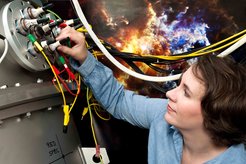Fellowship for MPE PhD student Agata Karska

Agata Karska works on her doctoral thesis in the framework of the IMPRS at MPE and studies how today's stars and planetary systems are formed. She uses infrared data from "WISH" programme at the Herschel Space Observatory supplemented by sub-millimetre observations of ground-based telescopes to study the earliest phases of star formation.
In particular, the spectral lines of water and related molecules provide important clues to the physical processes and conditions around the protostar. In her dissertation, Agata Karska studies how the water and carbon monoxide lines depend on the physical parameters of the source and how the gas cooling changes over time, while the young star develops. Ultimately the WISH data give insight into how and where water is produced in space, and how it ends up in planetary systems like ours.
Detailed information about the program "For Women in Science" and the winners can be found here.
The WISH key program is led by Agata Karska's PhD supervisor, Ewine van Dishoeck. More information on WISH can be found here.
For more information about PACS (Photodetector Array Camera and Spectrometer), one of three instruments on board Herschel, which was developed in the IR group at the Max Planck Institute for Extraterrestrial Physics, click here.
